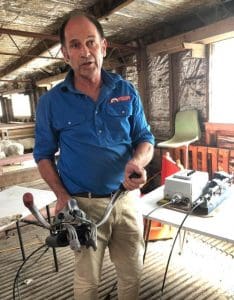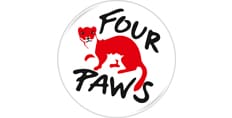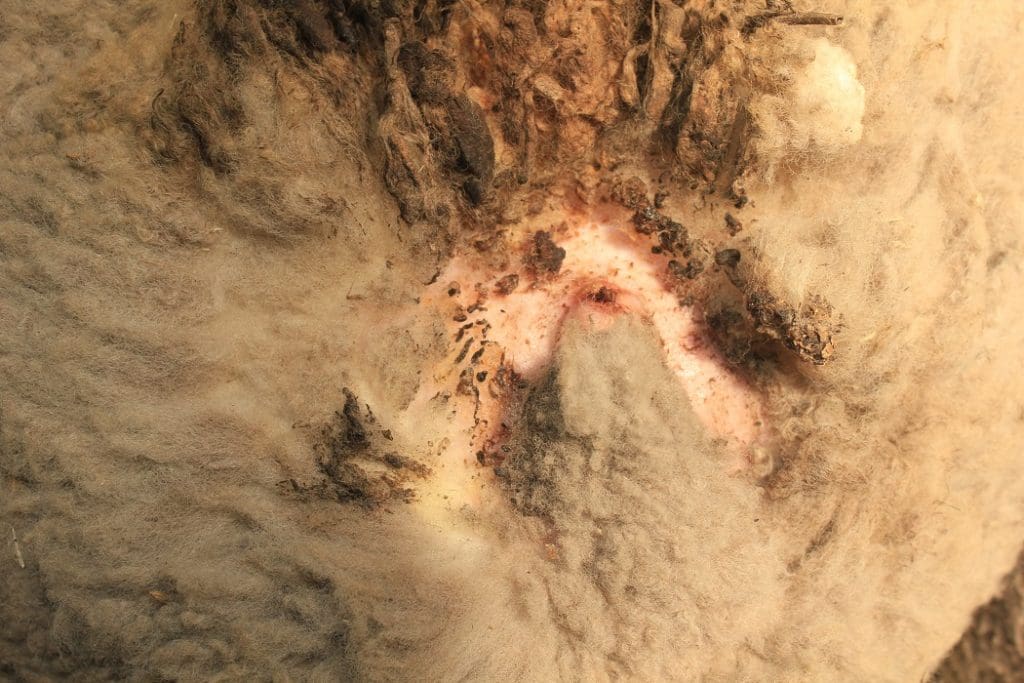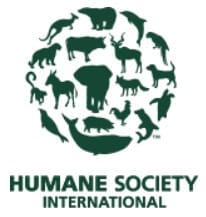
Sheep freeze branding creator Dr John Steinfort
ANIMAL protection groups are maintaining their opposition to sheep freeze branding as an alternative to surgical mulesing, as growers embrace the process and plans are made to independently research its welfare impacts.
Thousands of wool producers across Victoria and New South Wales are lining up to have their 2019-drop lambs undergo the process rather than mules to reduce the risk of flystrike.
But the Humane Society International Australia and FOUR PAWS this week reiterated their opposition to any sheep breech modification and support for selective breeding to remove wrinkle and lessen flystrike susceptibility.
They said the sheep freeze branding process developed by Victorian veterinarian Dr John Steinfort is not the solution to surgical mulesing. The liquid nitrogen application process involves clamping and freezing breech wrinkle and wool to increase the area of bare skin under the tail.
 FOUR PAWS Australia head of programs Jessica Medcalf said there is currently no robust independent scientific evidence to prove that steining or ‘freeze mulesing’ does not cause significant pain. The groups currently oppose any form of sheep breech modification.
FOUR PAWS Australia head of programs Jessica Medcalf said there is currently no robust independent scientific evidence to prove that steining or ‘freeze mulesing’ does not cause significant pain. The groups currently oppose any form of sheep breech modification.
“Alongside HSI and a growing list of brands, FOUR PAWS is opposed to wool from freeze-mulesed sheep being classified as ‘non-mulesed’.
“We have highlighted this to the Australian Wool Exchange which is currently reviewing its National Wool Declaration, the scheme whereby producers classify their wool as mulesed or non-mulesed for buyers in the supply chain,” Ms Medcalf said.
RSPCA Australia has also previously told Sheep Central it does not support any breech modification on sheep in the absence of a breeding program aimed at achieving a flystrike-resistant flock. The welfare body sees a need for pain research into sheep freeze branding process that should be peer reviewed and published in a reputable journal.
Dr Steinfort has joined with Australia’s largest independent wool marketer Australian Wool Network to form AgVet Innovations, to develop and promote sheep freeze branding, and the company’s general manager Stuart Blair said he believed the results of upcoming university trials will validate it is a welfare-considerate process that protects animals against deadly flystrike. The independent trials will take place in the first half of next year during the lambing season, with peer-reviewed results available shortly after.
Sheep freeze branding technology will initially be rolled out across the Western District of Victoria and southern New South Wales using specialised dispensing units operated by livestock contractors with potentially more than 40,000 sheep processed. Existing independent contractors are being trained in the use of an automated handpiece.
“This one-off application uses a total skin depth freeze which deactivates the nerves creating numbness on the targeted site,” Dr Steinfort said.
“The animals then continue as if nothing has happened.
“The process can be used at lamb marking, weaning or as weaners,” he said.
“Producers agree the animals jump freely out of the cradles, mother up and move readily back to the paddock without setback.
“Producers continually acknowledge the unhindered weight gains, producing better weaning rates and survival,” Dr Steinfort said.
“Research has shown these sheep produce nine percent more wool than a sheep which has been mulesed using pain relief – evidence shows there are no setbacks from the procedure.”
Mr Blair said the HSI and FOUR PAWS claim that sheep freeze branding is painful is based on a report produced a number of years ago.
“The technology used has evolved significantly since that time and the two processes cannot be compared.”

CSIRO principal research scientist Dr Ali Small.
CSIRO’s principal research scientist Dr Ali Small said the current sheep freeze branding technique differs substantially from what was evaluated in 2015-16.
“Therefore, I’m not in a position to comment on welfare assessments for the current technique.
“In our 2015-16 study, we noticed that the postures of the sheep we evaluated were different from those demonstrated by sheep undergoing surgical mulesing,” she said.
“We only scored ‘abnormal’ or ‘normal’ for postures, and the counts of ‘abnormal’ did not differ significantly between the two groups.
“For future evaluations, it would be interesting to include measures such as movement, activity, head up versus head down, Visual Analog Scale or QBA – both measures of the apparent overall ‘attitude’ of the animal.”
Freeze branding classification under review

A Sierra Park Merino lamb breech after steining.
Wool from sheep treated with freeze branding is currently classified under Australia’s current National Wool Declaration as ‘non-mulesed’, However, wool integrity schemes such as Textile Exchange’s Responsible Wool Standard, New Zealand’s ZQ Merino, and Australia’s NewMerino standard do not recognise wool from freeze-branded sheep as ‘non-mulesed’.
The Schneider Group, with its Authentico integrity scheme, is supportive of the freeze branding concept, but G. Schneider Australia managing director Tim Marwedel said the company would like to see more scientific evidence, so its clients can decide individually, based on their own consumer preferences.
“Animal welfare agencies will also have some influence on these decisions.
“We are interested in the next version of the NWD to have the opinion of the industry,” Mr Marwedel said.
Some Italian processors and brands are also yet to take a position on sheep freeze branding and are waiting on the results of the pain research, and on AWEX’s position on the process in an NWD review report due soon.
 Humane Society International’s program manager for animal welfare Georgie Dolphin said selectively breeding the wrinkle from a flock is a pain-free solution which also protects the sheep from flystrike across all of the body, rather than just their breech area.
Humane Society International’s program manager for animal welfare Georgie Dolphin said selectively breeding the wrinkle from a flock is a pain-free solution which also protects the sheep from flystrike across all of the body, rather than just their breech area.
“With the right genetics it can be achieved within just five years or less.
“Literally millions of lambs are subjected to mulesing each year and shifting towards another form of breech mutilation is not the answer for modern farming,” she said.
“We have spoken to numerous wool growers across the country who have successfully made the transition to plain-bodied sheep and are reaping the rewards.”
Mr Blair said AgVet Innovations recently welcomed a number of representatives from international brands to demonstrations in order to provide visibility of the Sheep Freeze Branding process.
“We hope that animal welfare bodies would welcome any process shown to be welfare considerate that helps move the industry away from mulesing whilst improvements in sheep genetics continue to be made.
“We see sheep freeze branding as an interim solution that allows Australian growers to stop mulesing whilst genetic improvements in breeding plainer-bodied sheep continue to be made,” he said.
“The reliance on other management techniques, such as the use of chemicals has other negative impacts, such as chemical residues and increased resistance.
“We are hopeful of an outcome from the NDW review that would provide encouragement for growers to adopt alternative solutions to the current practice (mulesing).”

If that photo is the best they have and a presume it is, then we have a huge problem.
Not every sheep in any flock gets breech strike; every Merino flock carries within it variation of bare skin area and wrinkle around the anus and tail.
These desirable traits are in every flock that I mulesed and in my view should be included in the mix of parameters for selective breeding to eliminate the need for any type of mulesing.
In 2004, the wool industry peak body promised to end mulesing by 2010. Why hasn’t mulesing ended? I think the answer is poor leadership. The most influential man in the Australian wool industry appeared on national television with the head of People for the Ethical Treatment of Animals expressing how offended wool growers were of PETA tactics.
In my view, wool growers are still offended by PETA tactics and don’t really see the bigger picture. I think most Merino wool growers don’t really understand animal welfare at the level needed to breed animals that do not suffer in the Australian environment.
A decade and a half has gone by and still mulesing continues. What a bunch of laggards many wool industry participants are.
John Bodey. Former wool grower, mulesing contractor and Agriculture Victoria animal health officer.
By adopting the genetic solution to breeding the wrinkle from the merino the need to mules will be eliminated. Further, the need to use chemical for fly control will be a thing of the past.
I’m wondering what this is about..freeze branding or mulesing or freeze-mulesing. It’s got me stuffed. The idea that sheep and lambs are so dumb that abuse is OK is a long term human exhibition of dumbness. This Stuart Blair said he believed the results of upcoming university trials will validate it is a welfare-considerate process that protects animals against deadly flystrike is wrong. Mulesing only protects the area around the anus…flystrike is also commonly from neck to tail…mulesed or not. Yes mulesing and the after effects make it less attractive to blow flies.
“Research has shown these sheep produce nine percent more wool than a sheep which has been mulesed using pain relief “..show me the research and the conditions of research.
I don’t accept that graziers or contractors give a toss about the pain they inflict…a few drinks cures any residuals and yes, even with castration rings, the lambs hop around a while then settle, but does that stop pain, or let them think its normal? If you can recall how painful it is to get injections at the lower spine area…imagine being skin-stripped there even if unintelligent. Get serious about a solution and enforce it…none of this ‘grazier can decide’ business.
It’s not always just a simple matter of ‘selective breeding’ for five years for many producers. We spent months looking for a stud this year to help us progress down the non-mulesing path, only to find that the majority are western and low-rainfall based and did not suit our very high rainfall climate. Not much use buying in mulesed sheep that get fleece rot during the first summer rains. As it is, we trialled several studs, three of whose rams have already broken down in the hooves prior to their first joining. They just can’t handle the high rainfall conditions and this is in a relatively dry year. Currently, we see this freeze branding as an opportunity to reduce many of the effects of traditional mulesing until we can reach our goal of breeding non-mulesed sheep.
The question needs to be asked? Who is running the wool industry, the growers with their lifetime of experience, personal interest and knowledge, or the city-based animal activists with very little experience, no knowledge and no financial interest?
Let the industry get on with the job of finding a way around the necessity to mules lambs, a job nobody likes or enjoys doing.
John Mckeon Hillston NSW, wool grower of 50 years experience.
John McKeon, you are so right: “Who is running the wool industry?”. AWI has very strong views … “keep mulesing until a viable alternative is found.”. You have strong views. Most in the industry have strong views. The welfare groups have strong views. City folk have strong views. None of them matter, because they don’t buy any wool.
This is the easiest equation to solve. One just asks everyone that buys wool: what do you want, what can I produce to make your job easier, to sell more woollen apparel.
We need to take the self-interest and politics out of the industry and let it simply proceed forward.